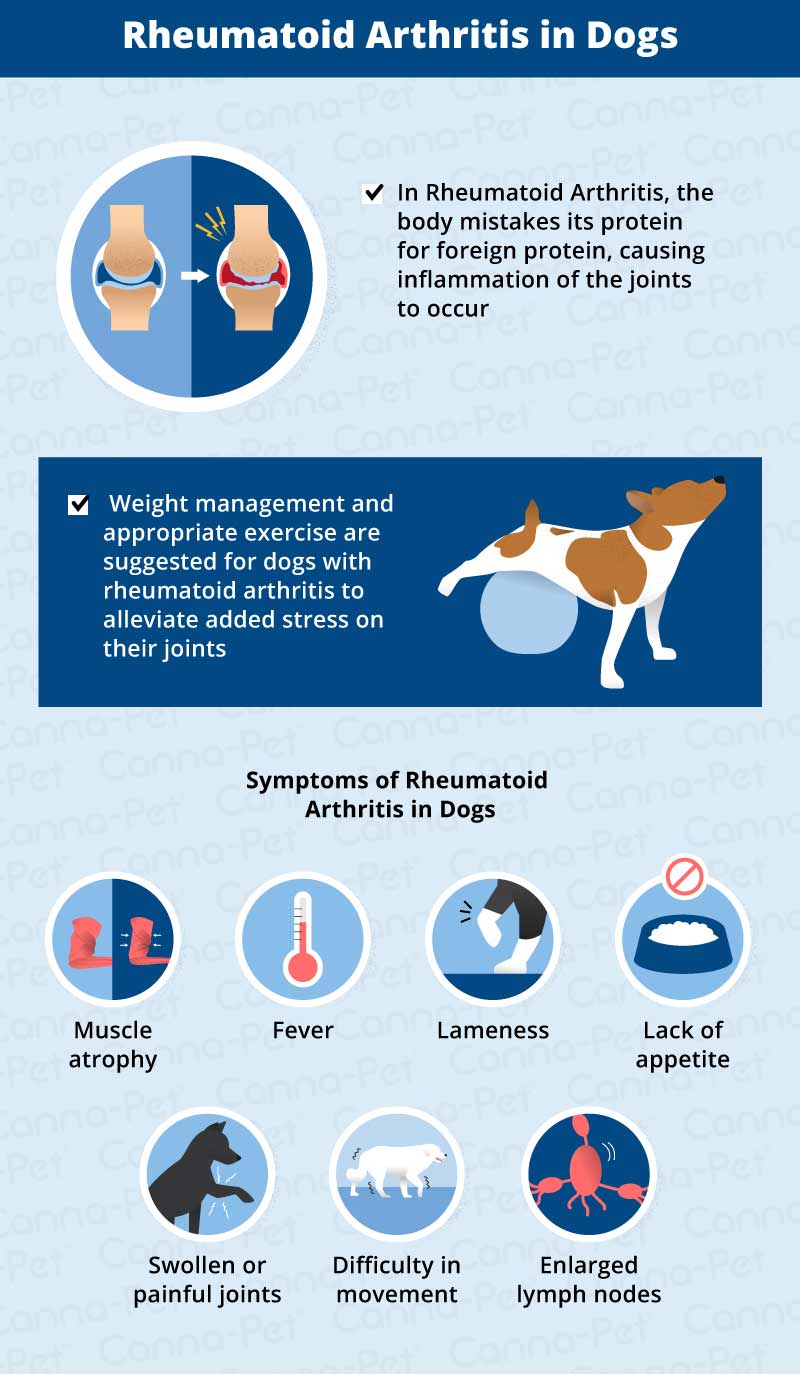No pet owner ever wants to see their furry friend sick. That’s why it is critical to give them the proper nutrients they need for a strong and healthy immune system. Minor colds usually won’t need veterinary attention, however, if your dog has an immune mediated disease, symptoms and treatments will likely be much more serious. An immune mediated disease is a condition that occurs when the immune system abnormally attacks the central nervous system, leading to serious health complications.
The two most common canine immune mediated diseases result in anemia. To begin, let’s take a closer look at immune mediated hemolytic anemia (IMHA). In its early stages, IMHA is treatable, however in an acute stage, it can be life-threating.
Immune mediated thrombocytopenia (ITP) is another disease that causes a failure in the immune system. While many assume that these diseases are quite similar, they require different treatment strategies and should be dealt with on a case-by-case basis.
Two forms of IMHA exist: primary IMHA and secondary IMHA. These diseases have different symptoms and causes, but are both anemic diseases that require specialized treatment. While symptoms of anemia like lethargy or lack of appetite can be a sign of IMHA, some dogs may not have any symptoms at all during the earlier stages of the disease.
ITP symptoms are mainly related to spontaneous bruising or failure to clot blood, which can result in excessive bleeding. If you are concerned that your dog may be suffering from an Immune Mediated Disease, read below to learn more about symptoms and treatment. Your dog will likely need veterinary attention to ensure proper treatment and a safe recovery.
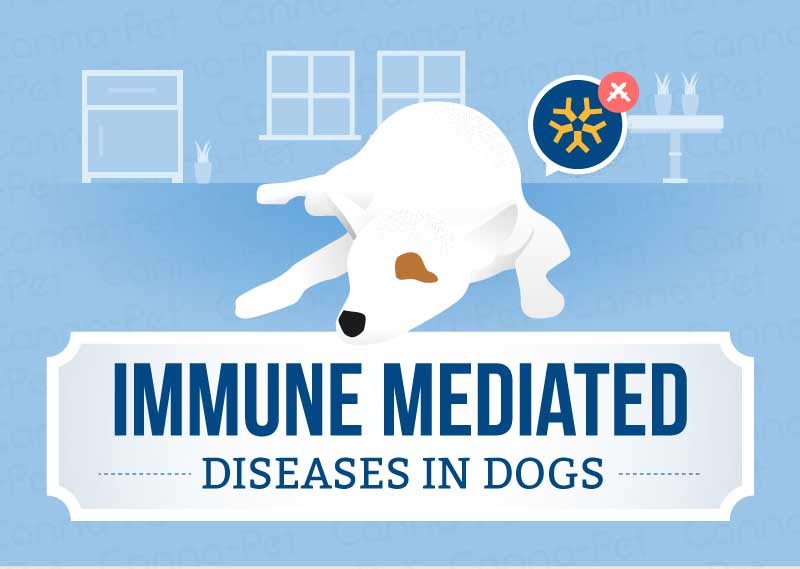
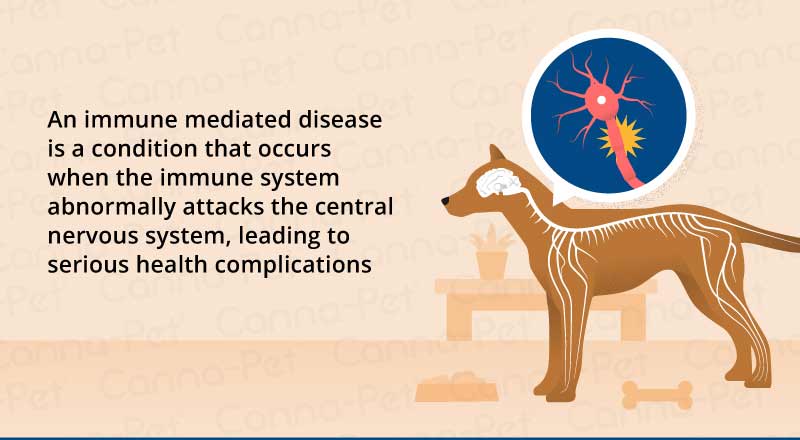
Types of IMHA in Dogs
A healthy immune system can normally defend itself from bacterial, fungal, parasitic, and viral infections that attack your dog’s body. The immune system consists of antibodies, white blood cells, and other proteins and tissues that rid the body of unwanted substances. These antibodies are key components of the immune system, which are programmed to destroy antigens – the foreign substances that cause sickness.
Cells are typically marked and registered as “self” and “non-self” cells, which help these antibodies determine which cells should be kept or rejected. This is how dogs, as well as humans, fight off colds and illnesses after no more than a few days at a time.
However, when the dog’s immune system mistakenly recognizes its own red blood cells as foreign substances, these antibodies destroy healthy red blood cells that are needed to carry oxygen throughout the body. This indicates an immune system failure, which leads to an essential “short circuit” of the immune system, and causes tissue failure.
Red blood cells are produced in the bone marrow, however if the body attacks these cells, the bone marrow will not be able to keep up with the high demand of red blood cells. Anemia will result from this deficiency and the body’s immune system will be compromised.
In the case of primary IMHA, the red blood cell count falls far below the normal count. There are no proven causes for primary IMHA, however there are many theories that are tied to this illness. Some of these theories stem from additives found in dog food, pollutants from the environment, cancer, and vaccines that could have altered the immune system’s functionality.
Other theories link the disease to genetic predisposition or hormonal influences, which are more natural processes, but specialists and researchers still cannot trace most cases of primary IMHA back to its roots.
In cases of secondary IMHA, anemia occurs when the red blood cells do not function properly. This happens when an underlying disease, drug, or toxin modifies the surfaces of a dog’s red blood cells. Similar to primary IMHA, the red blood cells are then destroyed and cannot be replaced quickly enough by the bone marrow. This can sometimes stem from a cancer or infection, blood parasites, chemicals and toxins, or even allergic reactions.
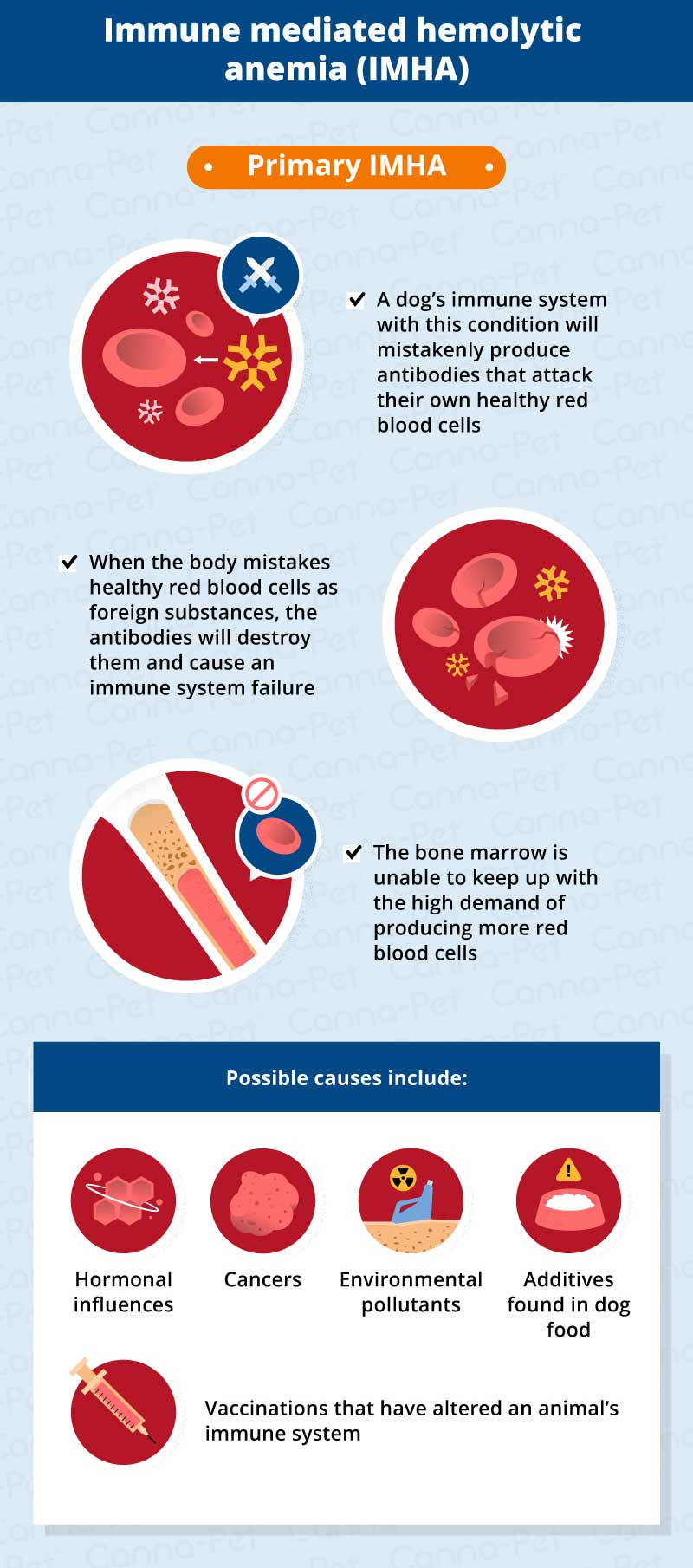
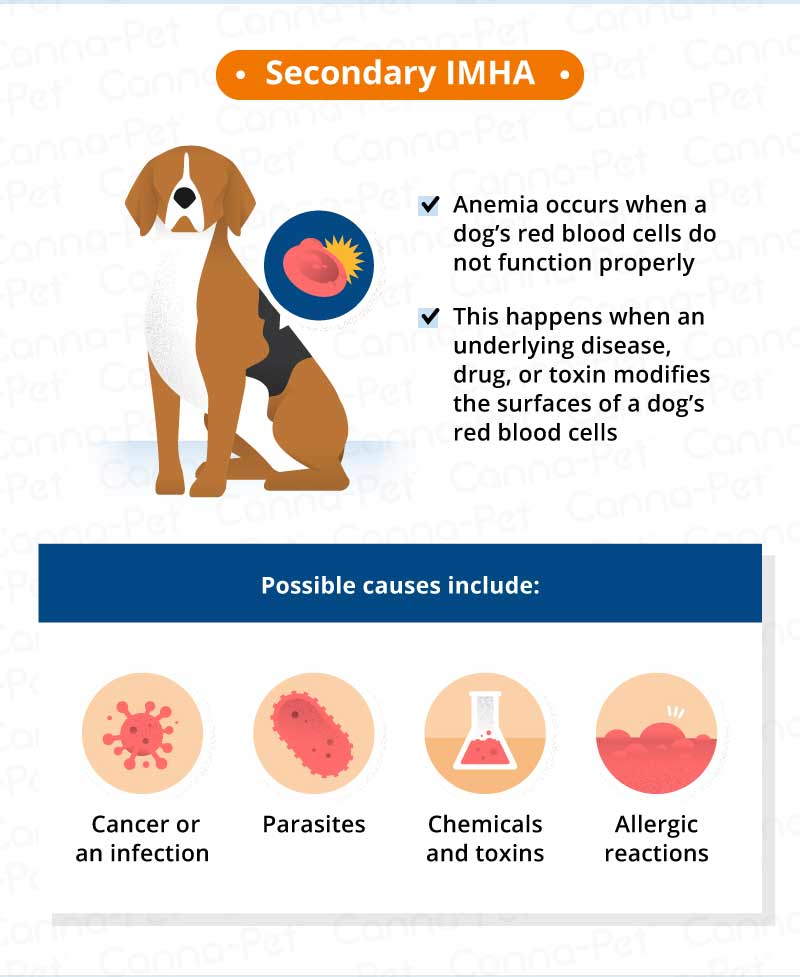
Typical IMHA Symptoms
Symptoms can vary from dog to dog. Irish Setters, Poodles, English Springer Spaniels, American Cocker Spaniels, Dachshunds, Miniature Schnauzers, and Doberman Pinschers are said to be the most commonly affected breeds, especially within the ages of one to thirteen years old. Female dogs seem to be slightly more predisposed to this illness than their male counterparts.
Normal symptoms of anemia can include lethargy, poor appetite, rapid or shallow breathing, jaundice, weight loss, and a rapid pulse or heart rate. Because anemia is just one symptom of IMHA, other signs of IMHA can include melena (black stools due to hemorrhage, or partly digested blood, in the gastrointestinal tract), petechia (red or purple spots on the body due to minor hemorrhages), or ecchymoses (patches or bruises that may appear as skin discoloration).
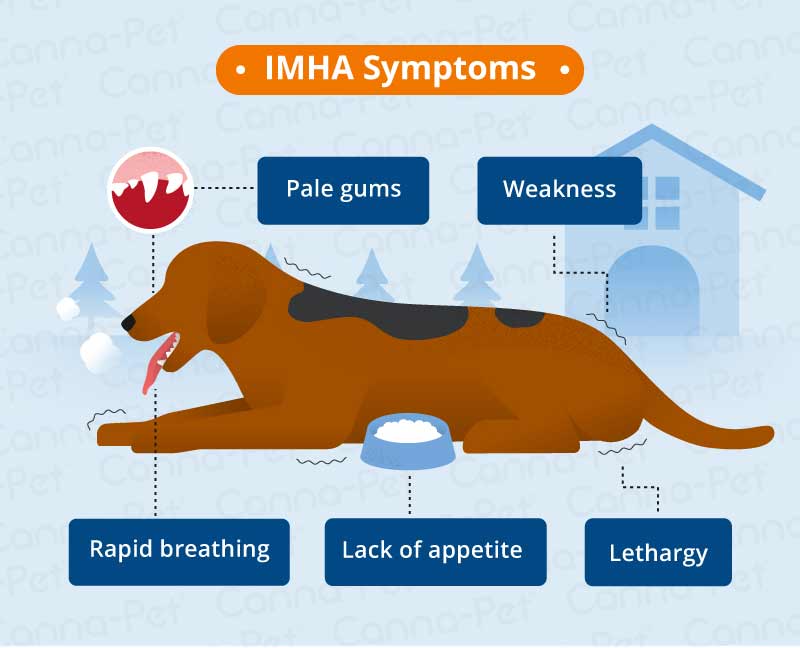

Acquiring Proper IMHA Diagnosis
When taking your dog to a veterinarian, several tests should be taken in order to create a specific treatment plan for your pet.
A complete blood count and reticulocyte count will determine whether your dog is anemic or not, and will also show if red blood cells are being produced in response to the anemia. If the results are abnormal, a bone marrow sample might be needed to investigate the production of red blood cells further.
Depending on your veterinarian, they may want to do further testing to fully understand the severity of the illness. These tests may include chemistry tests for kidney, liver, and pancreatic function, electrolyte balance tests, and urine/fecal tests to screen for infections, diseases, parasites, or overall internal organ functionality.
In addition to the biochemical profile and urinalysis tests, x-ray images might be helpful to screen vital organs including the thorax, abdomen, heart, lungs, liver, and kidneys.
Echocardiography and ultrasounds are also used to see if there are any abnormalities in the body’s high-functioning areas. These tests, of course, should be discussed with your veterinarian before determining whether it is necessary for treatment. Keeping a checklist of symptoms that your dog has faced may be helpful when deciding which tests to run.
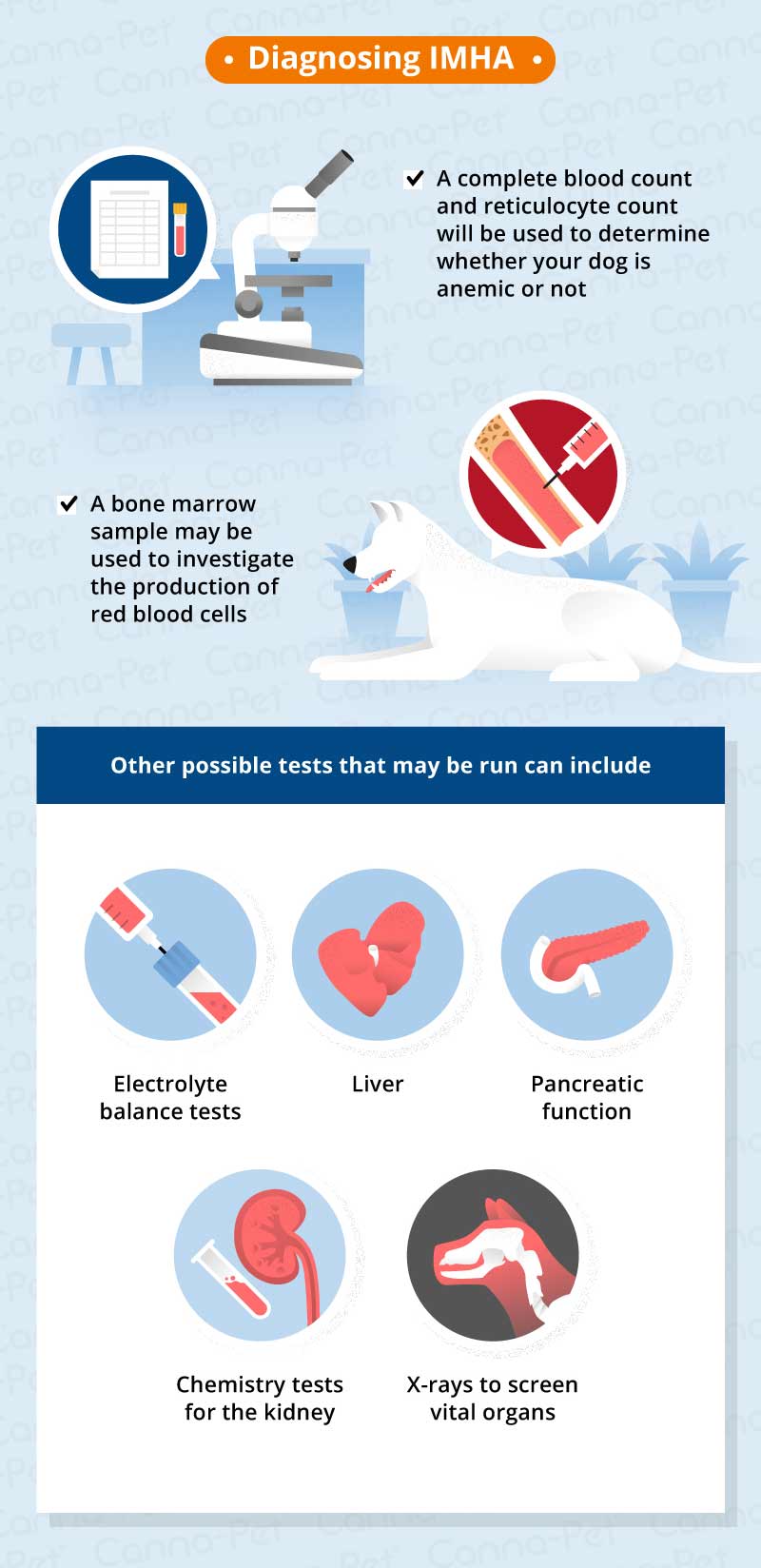
Treatment of IMHA in Dogs
IMHA can be life-threatening in acute cases. Therefore, it is necessary to stabilize your dog as soon as possible if he has an immune deficiency. Hospitalization is necessary to immediately stop red blood cells from being destroyed by their immune system. In order to maintain proper red blood cell levels, a blood transfusion or fluid therapy may be the only solution to stabilize your pet.
In such cases that medical treatment does not appear to solve the issue, spleen removal may be necessary for your dog’s recovery. Again, your veterinarian will be the best resource for determining the right treatment strategy if your pet is diagnosed with an acute form. In instances of secondary IMHA, it is important to also identify the underlying cause that created these abnormally functioning red blood cells, as this will be critical for complete recovery.
In cases of 24-hour monitoring or specialty testing, it would be best to consult a number of specialists or veterinarians to figure out what the right route for your pet’s recovery should be. Some of these expenses can be extremely costly, and that is why you should always know all of your options before selecting a specific path.
Online discussion boards have helped pet owners find additional resources or recommended professionals in this field of work. They can also help you find communities of other pet owners who can provide mental or emotional support throughout your pet’s recovery.
The timeline of your dog’s recovery can vary drastically depending on several factors. These include whether it is primary IMHA or secondary IMHA, how long your dog has had the disease, and what stage it has progressed to over time.
When caught early on, some dogs respond well to treatment and recover in a few weeks’ time. However, many dogs will need long-term or even lifelong treatment in more serious cases – mostly when dealing with idiopathic IMHA.
During stabilization, your dog should be on a strict resting agenda. In more serious cases, treatment will be needed continuously, or until your dog responds to his medical treatment. Follow-up appointments are crucial during the recovery stage of IMHA in order to monitor your dog’s red blood cell levels.
It is important to be thorough and proactive while fighting the disease – even after treatment is nearly finished. Schedule check-ups with your vet every week during the first month of recovery, then once a month for the next six months, and then two to three visits per year just to be safe.
Every dog will have a different treatment regimen, so be sure to talk to your veterinarian to lay out a good plan that you feel comfortable with – this may mean scheduling less or more visits to ensure that your pet’s levels are performing how they should.
It might be helpful to ask your veterinarian for recommendations of specialists who have experience treating IMHA. These specialists often give pet owners a more specific treatment plan, and can provide them with greater insight on the illness and its severity.
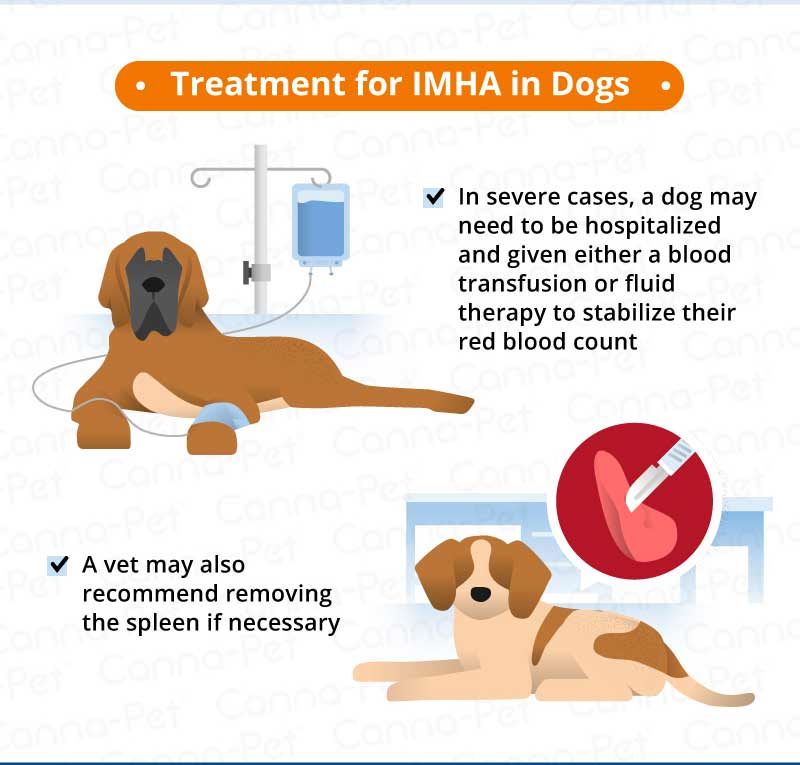
Overview of ITP in Dogs
When identifying blood vessel damage, the platelets in your dog’s blood will not function properly if the blood is not clotting. This may cause frequent bruising to occur. Usually, if your dog has ITP, the immune system changes and starts responding to a parasite, tumor, or drug before the platelets are destroyed.
Another reason why platelet count might be low is that the bone marrow might be damaged or not functioning properly. This could be the result of chemotherapy drugs or bone marrow cancer. Knowing the risks of other diseases and treatment strategies is an important step in preventing a disease like ITP from occurring.
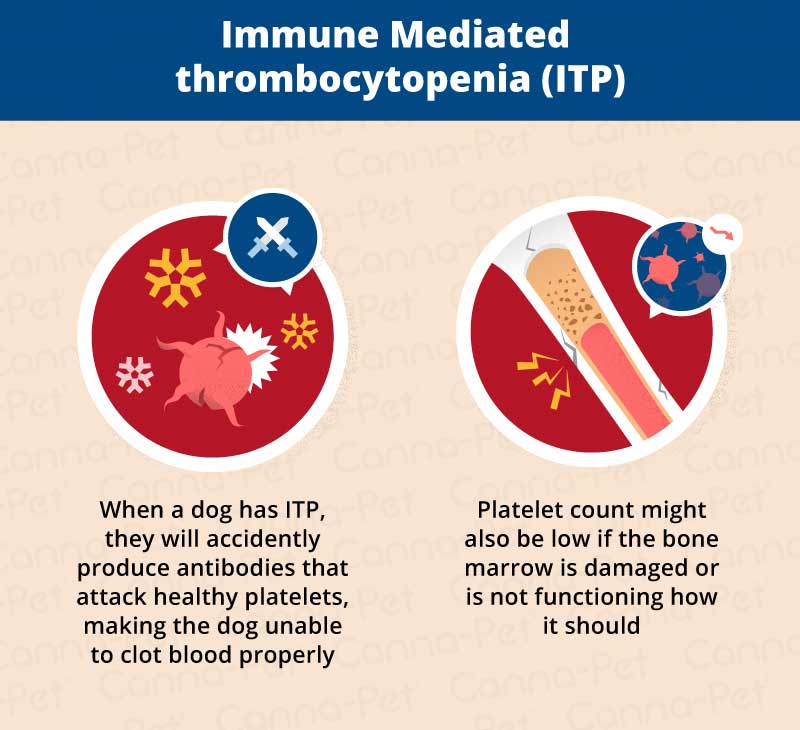
Symptoms and Signs of ITP in Dogs
Poodles, Cocker Spaniels, and Old English Sheepdogs tend to have a higher risk of developing ITP than other breeds. These dogs will typically be middle-aged rather than younger puppies.
While rapid bruising and discoloration of skin has been mentioned earlier as symptoms of ITP, other symptoms will occur depending on the affected area of the body. Gums and oral surfaces can become easily discolored with bruising, whites of the eyes may lose their sparkle, and petechiae or ecchymosis can often occur. Small amounts of blood found in urine, feces, or coming from the nose are also common signs of platelet dysfunction.
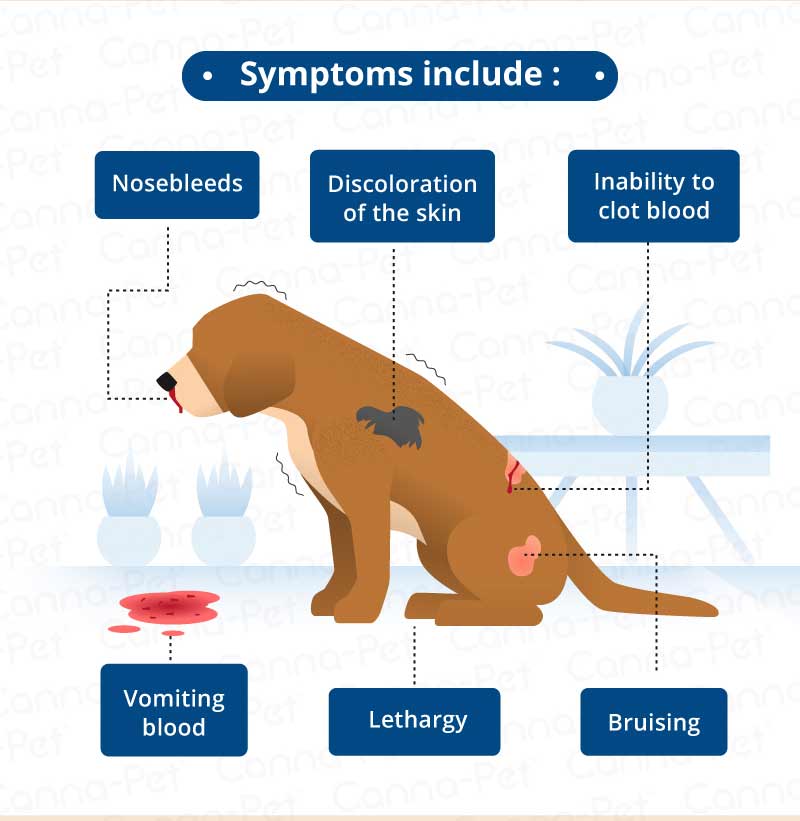
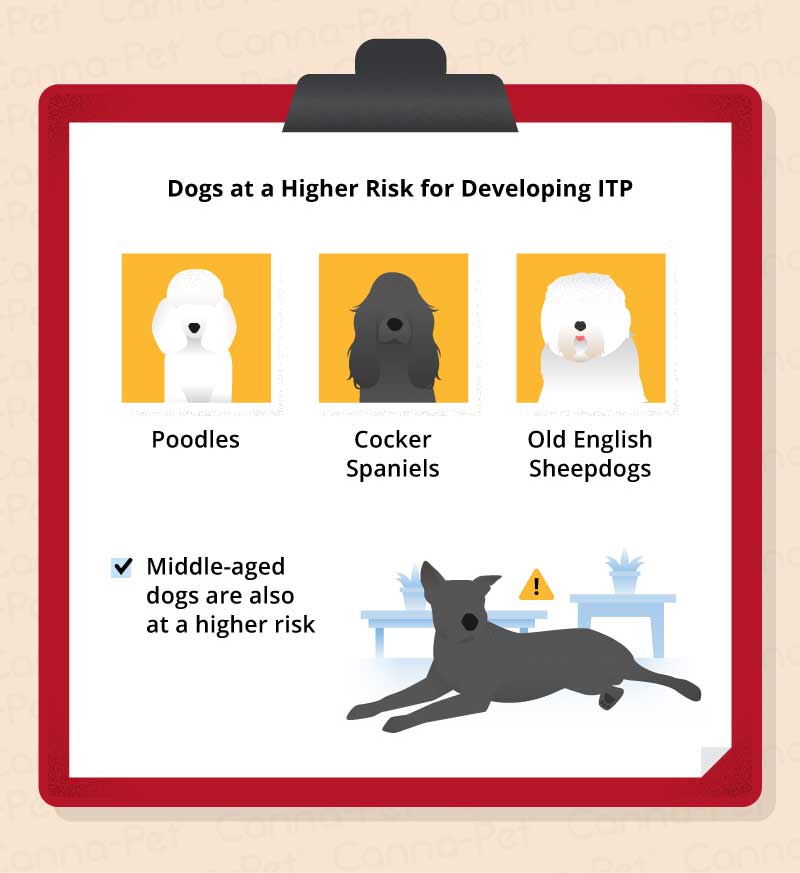
Treatment for Dogs with ITP
There are a number of different treatment and therapy methods that can be used to counteract ITP. These treatment options involve suppressing the immune system in order to keep platelets from being destroyed by the phagocytes of the spleen. Some of these treatments include prednisone or dexamethasone (steroid hormones), vincristine (chemotherapeutic medication), or azathioprine or cyclophosphamide (also used in chemotherapy).
Blood transfusions might be necessary to stabilize your dog, but this is not a long-term solution. Your dog will need to be able to produce his own platelets, and a transfusion will only last about 12 hours. The next step would be a splenectomy, or spleen removal, which is a common solution in severe cases. By removing these phagocytes, platelets will no longer be destructed where they interact with the spleen.
Responses in dogs have been harder to predict and treat through veterinary medicine. Many of these have long-term implications and carry the risk of exhausting or damaging side effects. It is important to carefully talk with your veterinarian about each treatment option before choosing the best recovery process for your dog.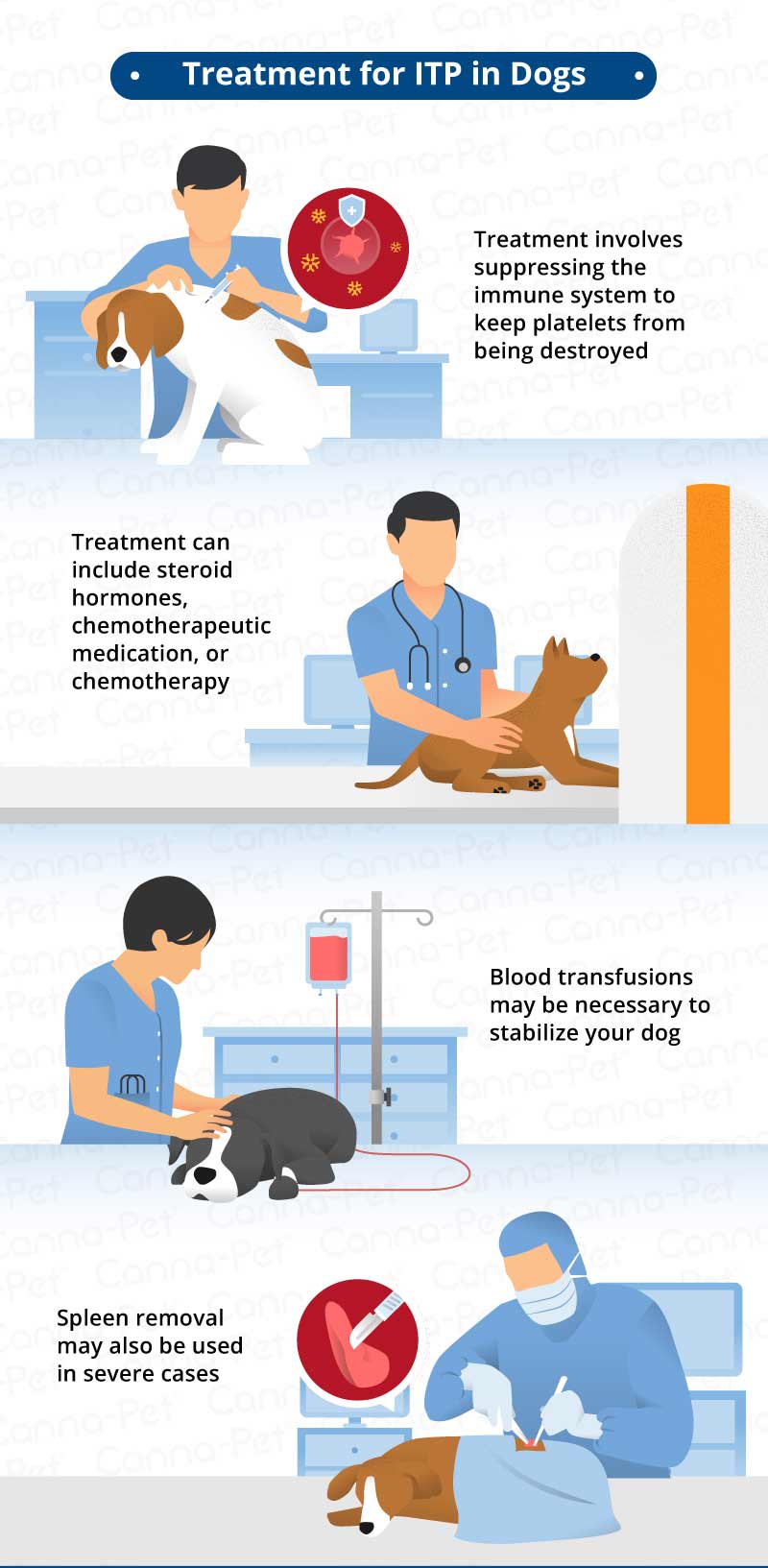
Rheumatoid Arthritis in Dogs
Rheumatoid Arthritis is another type of immune-mediated disease, although it is very rare and difficult to diagnose in dogs. In Rheumatoid Arthritis, the body mistakes its protein for foreign protein. This causes the body to form antibodies against its protein, called “rheumatoid factor.”
These rheumatoid factor antibodies and protein form immune complexes, which end up deposited on the joints. The immune complexes are what triggers an inflammatory response. The dog’s body reacts to the inflammation to try to get rid of the injurious immune complexes, although this reaction ends up creating more damage to the bones, joints, and cartilage.
The most common symptom of rheumatoid arthritis in dogs is lameness, or movement that is difficult to impossible, ranging from mild to severe depending on the animal’s medical case. Other symptoms include fever, enlarged lymph nodes, lack of appetite, muscle atrophy in the affected limbs, and swollen and painful joints.
These symptoms can come and go, which make it difficult to track the dog’s health history and diagnose. Veterinarians diagnose rheumatoid arthritis when a physical exam and animal background warrant further investigation through an x-ray of the joint bones. Biopsy of joint tissues to test for inflammation, as well as a special blood test, may be ordered.
The particular blood test looks for the rheumatoid factor. However these results are often inconclusive as many dogs test positive for the factor who do not have rheumatoid arthritis, and all dogs who do have rheumatoid arthritis do not always test positive for the factor. This makes proper diagnosis tough. Once a positive diagnosis has been given, dogs are treated to control their symptoms and prevent further injury. Weight management and appropriate exercise is very important for dogs with rheumatoid arthritis to alleviate added stress on the joints. There is no cure for rheumatoid arthritis, so treatment focuses on maximizing the comfort and mobility of the dog.
When it comes to immune mediated diseases in dogs, make sure you are able to recognize the side effects as early on as possible. Most importantly, if your dog has been diagnosed with this illness, do not give up hope. With an aggressive treatment plan and veterinarian support, you can increase your dog’s chances of survival and get them back to living a happy and normal life.
